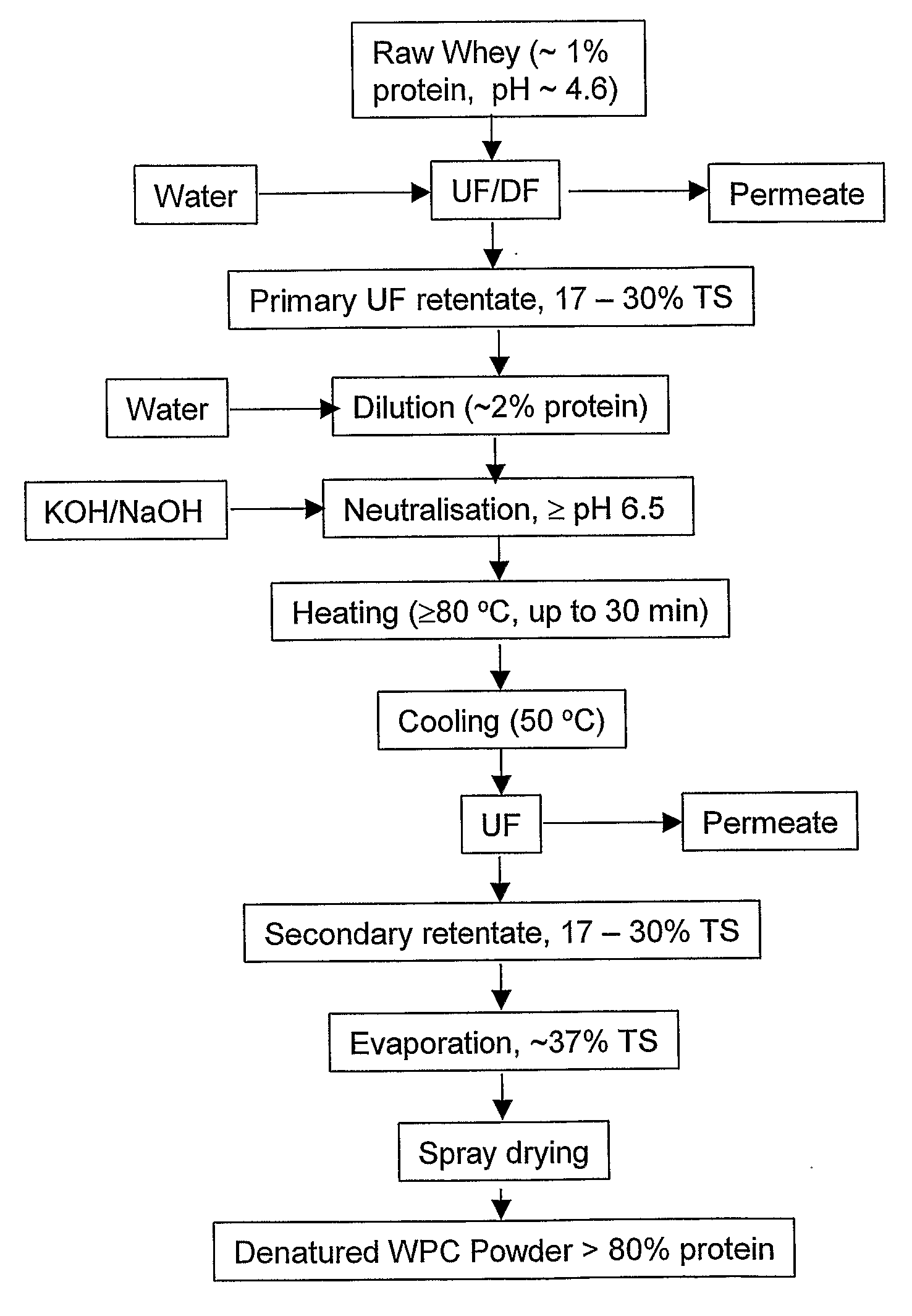Whey Product and Process
a technology of whey protein and product, applied in the field of whey protein concentrate, can solve the problems of adverse flavour effects of higher phs, and achieve the effect of increasing protein content and viscosity
- Summary
- Abstract
- Description
- Claims
- Application Information
AI Technical Summary
Benefits of technology
Problems solved by technology
Method used
Image
Examples
example 1
Demonstration of the Formation of Low Molecular Weight Aggregates During Heating
[0055]Raw whey having approximately 1% protein and a pH of approximately 4.6 was taken from an acid precipitation of casein from skim milk by addition of 10% sulphuric acid. It was ultrafiltered until the solid content was approximately 20% total solids. The retentate was diluted with purified water to provide a diluted retentate having 2% protein. The pH was adjusted using 10% KOH (w / v) to either 7.0 or 7.5. The pH adjusted diluted retentate was heated to 80° C. for 30 minutes. Samples were taken and subjected to native-PAGE (Havea, P., Singh, H., Creamer, L. K. & Campanella, O, H. Electrophoretic characterization of the protein products formed during heat treatment of whey protein concentrate solutions. Journal of Dairy Research, 65, 79-91, 1998). These results showed (FIG. 5) the quantities of β-lactoglobulin and α-lactalbumin decreased with heating time (indicated by the decreasing band intensities) ...
example 2
Demonstration of the Ability of the Invention to Provide WPCs with Different Levels of Protein Denaturation
[0056]A process following that shown in FIG. 2 provided raw whey having approximately 1% protein and a pH of approximately 4.6 from an acid precipitation of casein from skim milk by addition of 5% sulphuric acid. After clarification, the whey was ultrafiltered until the solid content was approximately 20% total solids. The retentate was diluted with water to provide a diluted solution having 2% protein, and then the pH was adjusted using 10% (w / v) KOH to 6.9.
[0057]The diluted whey protein solution was separated into two streams and then heated at two different levels namely, run 1: 74° C. for 20 min, or run 2: 82° C. for 21 min. The heated whey streams were then cooled to 50° C. and ultrafiltered to provide secondary retentate lots containing ˜20% total solids. The retentate streams were then spray dried. The final powders were analysed and compared with standard unheated comme...
example 3
Demonstration of the Importance of the Need to Keep the Heated retentate at 40 to 60° C.
[0059]Two buckets (1 L) of heated retentate (about 20% total solids) were obtained from Run 2 Example 2 above. One bucket was stored at 20° C., while the second was kept at 50° C. The protein solution in the bucket stored at 20° C. started to form considerably thick to strong gel within an hour. The protein solution was considered too thick for further processing, and was discarded. The protein retentate in the bucket that was kept at 50° C., remained a solution for more than three hours. This time delay would allow further processing of the solution under commercial conditions, before gel formation.
PUM
 Login to View More
Login to View More Abstract
Description
Claims
Application Information
 Login to View More
Login to View More - R&D
- Intellectual Property
- Life Sciences
- Materials
- Tech Scout
- Unparalleled Data Quality
- Higher Quality Content
- 60% Fewer Hallucinations
Browse by: Latest US Patents, China's latest patents, Technical Efficacy Thesaurus, Application Domain, Technology Topic, Popular Technical Reports.
© 2025 PatSnap. All rights reserved.Legal|Privacy policy|Modern Slavery Act Transparency Statement|Sitemap|About US| Contact US: help@patsnap.com



